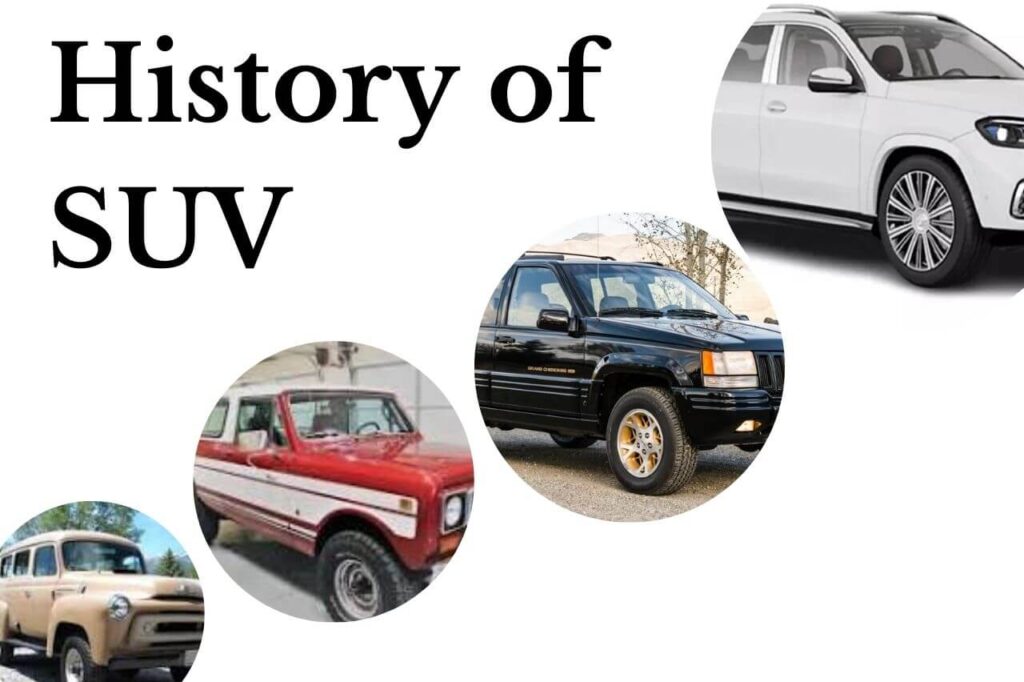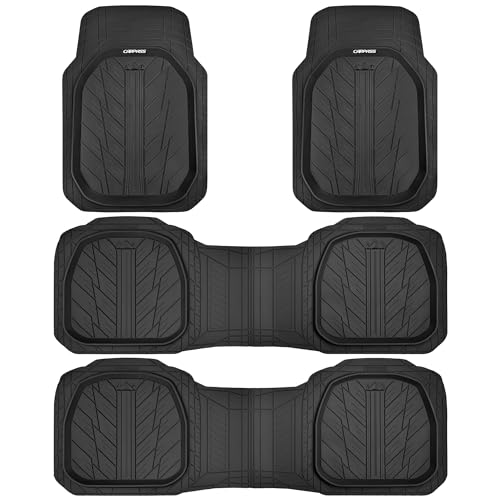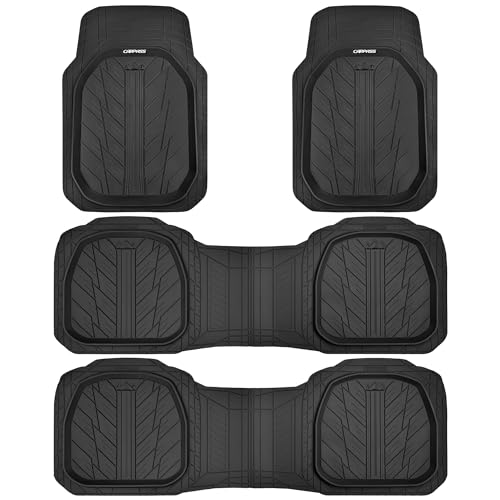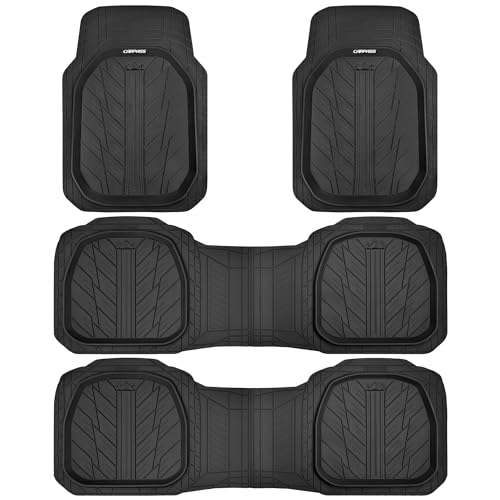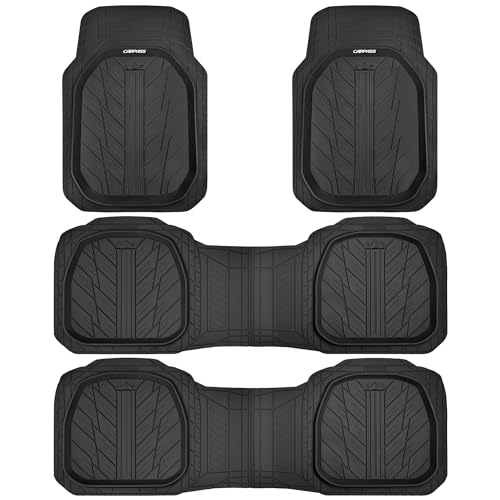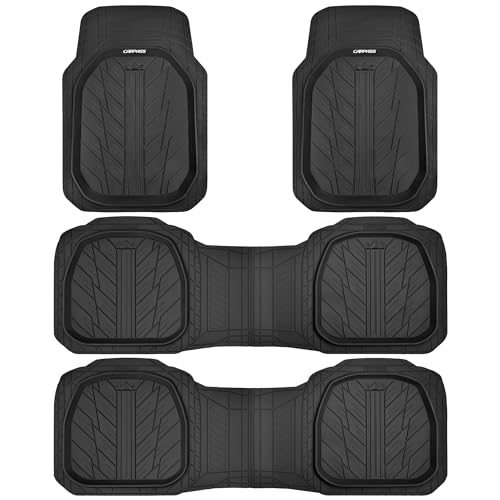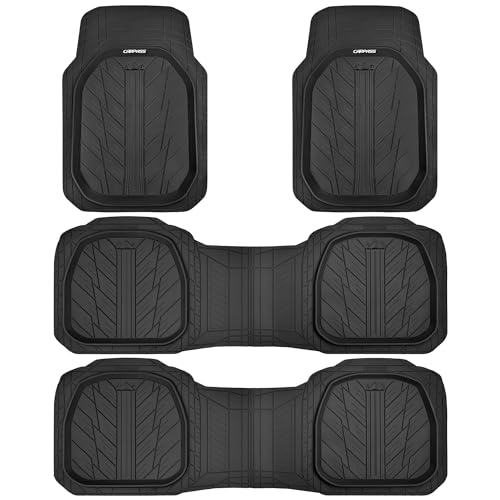SUVs have become ubiquitous on our roads, conquering cityscapes and highways alike. These versatile vehicles boast spacious interiors, impressive towing capabilities, and a commanding driving position. But where did these ubiquitous machines originate? Their history is a fascinating journey from humble military beginnings to the stylish and feature-packed SUVs we know today. Buckle up, as we explore the evolution of SUVs and uncover the stories behind these iconic vehicles.
The Early Days: From Battlefields to Backroads (1930s-1940s)
The story of the SUV begins not on a scenic highway, but on the battlefields of World War II. The need for a rugged, all-terrain vehicle capable of traversing muddy trenches and uneven terrain spurred the development of the first true SUVs.
The Early Days: From Battlefields to Backroads (1930s-1940s)
The story of the SUV begins not on a scenic highway, but on the battlefields of World War II. The need for a rugged, all-terrain vehicle capable of traversing muddy trenches and uneven terrain spurred the development of the first true SUVs.
Enter the Willy’s MB, the Icon We Now Call Jeep:
In 1941, the answer came in the form of the Willys MB, a lightweight, four-wheel drive vehicle built by the Willys-Overland Motors Company. This no-frills machine, affectionately nicknamed “Jeep,” became a symbol of resilience and maneuverability on the battlefield. Its simple design, powerful engine, and high ground clearance made it a game-changer for wartime transportation.
Land Rover: Another Early Off-Road Pioneer:
Across the Atlantic, another iconic off-road vehicle was taking shape. In 1948, the Land Rover emerged from the Rover Company in England. Inspired by the American Jeeps encountered during the war, the Land Rover was designed for agricultural use, tackling tough terrains and hauling heavy loads.
These early military SUVs, with their emphasis on functionality and off-road prowess, laid the groundwork for the civilian SUVs that would follow.
From Battlefield to Boulevard: The Civilian Transition (1940s-1960s)
The end of World War II saw a surplus of rugged Jeeps. These versatile vehicles, no longer needed on the battlefields, found a new calling: civilian life. With their proven off-road capability and durability, surplus Jeeps became a popular choice for farmers, ranchers, and outdoor enthusiasts. This surge in popularity planted the seeds for the civilian SUV market.
The Willys Wagon: A Family-Friendly Offshoot
Recognizing the potential for a more family-oriented option, Willys-Overland introduced the Willys Wagon in 1946. This civilian version of the Jeep offered an enclosed cabin, increased cargo space, and a more comfortable ride, making it a practical choice for families seeking adventure.
American Motors Corporation (AMC) Enters the Game: The Birth of the Luxury SUV
The 1960s saw a significant shift in the SUV landscape with the rise of American Motors Corporation (AMC). In 1963, AMC introduced the Jeep Wagoneer, a groundbreaking vehicle that redefined the SUV experience. The Wagoneer boasted a luxurious interior with features like automatic transmission, power steering, and an optional V8 engine. This move marked the entry of luxury SUVs into the market, catering to those who desired off-road capability with a touch of comfort and refinement.
The Rise of 4WD Systems for Civilian Use:
Another crucial development during this era was the introduction of four-wheel drive (4WD) systems for civilian SUVs. Previously, 4WD was primarily a military feature. However, companies like Jeep began offering 4WD options on civilian models, further enhancing their off-road prowess and appealing to a wider audience seeking all-weather capability.
The civilian transition transformed the SUV from a utilitarian military vehicle into a versatile option for families, adventurers, and even luxury car buyers. The stage was set for the SUV boom that would follow in the coming decades.
The Rise of the Station Wagon Rival: The 1970s and 80s
The 1970s and 80s witnessed a fascinating battle for dominance on American roads. Station wagons, known for their spacious interiors and car-like handling, held a strong position in the family vehicle market. However, a new contender emerged, challenging the station wagon’s reign – the SUV.
SUVs Take Center Stage:
During this era, SUVs began to gain significant traction as a viable alternative to station wagons. Their ruggedness, higher ground clearance, and towing capabilities appealed to families seeking a more adventurous option. Additionally, the rising fuel prices of the 1970s led manufacturers to develop more fuel-efficient SUVs, further enhancing their appeal.
The Jeep Cherokee (XJ) – A Turning Point for Modern SUVs (People Also Ask: What is considered the first modern SUV?):
A pivotal moment arrived in 1974 with the introduction of the Jeep Cherokee (XJ). This innovative model marked a significant departure from traditional body-on-frame construction used in earlier SUVs. The Cherokee (XJ) utilized a revolutionary unibody construction, where the frame and body are integrated into a single unit. This resulted in several advantages:
- Lighter weight: Unibody construction made the Cherokee (XJ) lighter than its predecessors, leading to improved fuel efficiency and handling.
- More comfortable ride: The unibody design offered a smoother and more car-like ride compared to traditional body-on-frame SUVs.
- Increased interior space: The unibody construction allowed for better packaging of interior components, creating a more spacious cabin for passengers and cargo.
The Jeep Cherokee (XJ) proved to be a game-changer, paving the way for a new generation of modern SUVs that offered a blend of off-road capability and on-road comfort.
Ford Enters the Fray: The Rise of the Ford Bronco
Not to be outdone, Ford entered the competition in 1966 with the introduction of the Ford Bronco. This rugged SUV offered a powerful engine and impressive off-road capabilities, directly competing with Jeep for the hearts of adventure seekers.
The battle between station wagons and SUVs intensified throughout the 70s and 80s. Ultimately, the versatility and rugged appeal of SUVs, combined with advancements like unibody construction, began to tip the scales in their favor. The stage was set for the SUV boom of the following decades.
Boom Time: The Golden Age of SUVs (1990s-2000s)
The 1990s and 2000s witnessed the golden age of SUVs. These versatile vehicles experienced a surge in popularity, becoming the dominant choice for many families and individuals. Several factors contributed to this phenomenon:
Safety First: A growing emphasis on safety played a significant role in the SUV boom. Consumers were drawn to the perception of increased safety offered by SUVs due to their larger size, higher ground clearance, and commanding driving position. This perception, while not always entirely accurate, fueled the demand for SUVs.
Cargo Kings and Queens: Another major factor was the ever-increasing need for cargo space. Families with active lifestyles and those who enjoyed outdoor activities found the ample cargo capacity of SUVs invaluable. Whether hauling sports equipment, camping gear, or groceries for a large family, SUVs offered unmatched practicality.
High and Mighty: The elevated seating position of SUVs provided a sense of control and improved visibility, appealing to many drivers. This vantage point also offered a more commanding presence on the road, adding to the allure of owning an SUV.
Ford Explorer and Toyota 4Runner: Leading the Charge:
This golden age was defined by several iconic models. The Ford Explorer, introduced in 1983, became a household name, offering a comfortable ride, ample space, and available off-road capability. Similarly, the Toyota 4Runner, introduced in 1984, established itself as a reliable and versatile option, known for its durability and impressive towing capacity. These models, along with many others, cemented the SUV’s position as the ultimate family vehicle and adventure companion.
Luxury Takes the Wheel: The Rise of High-End SUVs
The SUV boom extended beyond the realm of family vehicles. Luxury car manufacturers saw an opportunity to cater to a new breed of discerning drivers. Brands like Lincoln and Cadillac entered the fray with opulent offerings like the Lincoln Navigator and Cadillac Escalade. These high-end SUVs combined luxury features, powerful engines, and impressive towing capacities, appealing to those who desired a blend of capability and comfort.
The Modern Era: Diversification and Innovation (2000s-Present)
The SUV market in the 21st century is a far cry from its monolithic beginnings. Today, it’s a diverse landscape catering to a wide range of needs and preferences. This diversification is evident in several key trends:
A Size for Every Need:
Gone are the days when SUVs were all about imposing size. Manufacturers now offer a spectrum of SUV options to suit different lifestyles. Compact SUVs and subcompact SUVs have emerged as popular choices for city dwellers seeking maneuverability and fuel efficiency. Mid-size SUVs remain a popular choice for families, offering a balance of size, comfort, and capability. For those who require maximum space and towing capacity, full-size SUVs continue to reign supreme.
Crossovers Take Center Stage:
A significant development in the modern era is the rise of crossover SUVs. These vehicles bridge the gap between traditional SUVs and cars. They often utilize unibody construction, offering a car-like driving experience with the added benefit of increased ground clearance and cargo space compared to a sedan. Popular crossover models cater to various segments, from sporty options to fuel-efficient choices.
Going Green: Hybrid and Electric SUVs :
As environmental consciousness takes center stage, the SUV market is embracing electrification. Hybrid SUVs combine a gasoline engine with an electric motor, offering improved fuel efficiency compared to traditional gasoline-powered models. Furthermore, the development of electric SUVs is rapidly expanding, providing a zero-emission option for eco-conscious drivers who still desire the versatility of an SUV.
Safety First, Always:
The question of SUV safety (People Also Ask: Are SUVs safe?) remains a topic of discussion. While their size and weight may offer a perception of safety, it’s crucial to remember that all vehicles have their own safety profile. Modern SUVs are equipped with a plethora of advanced safety features, including:
- Automatic emergency braking
- Lane departure warning
- Blind spot monitoring
- Adaptive cruise control
These features work together to enhance driver awareness and prevent accidents. It’s important to research the specific safety features offered on each SUV model before making a purchase decision.
The modern SUV market is a dynamic space, constantly evolving to meet the needs of drivers. With a focus on diversification, innovation, and fuel efficiency, the future of SUVs looks bright.
10 FAQs About the History of SUVs
- Where did SUVs originate?
SUVs trace their roots back to World War II, where vehicles like the Willys MB (Jeep) were developed for military use on rough terrain.
- How did SUVs transition from military to civilian use?
After WWII, surplus Jeeps became available to the public, sparking interest in rugged, all-terrain vehicles for civilian life. The introduction of family-oriented models like the Willys Wagon further solidified the civilian SUV market.
- What was a turning point for modern SUVs?
The introduction of the Jeep Cherokee (XJ) in 1974 marked a significant shift. It utilized a lighter unibody construction, offering improved fuel efficiency, handling, and interior space compared to traditional SUVs.
- What factors contributed to the SUV boom of the 1990s and 2000s?
Several factors fueled the SUV surge, including:
- Perceived increase in safety due to larger size and higher seating position.
- Growing need for cargo space for families and active lifestyles.
- Elevated driving position offering a sense of control and improved visibility.
- What are some iconic SUV models from the golden age?
The Ford Explorer and Toyota 4Runner are prime examples, known for their comfort, space, and capability, making them popular family vehicle choices.
- How has the SUV market diversified in the modern era?
Today’s market offers a wider range of sizes, including compact, subcompact, and full-size SUVs to cater to various needs. Additionally, crossover SUVs have emerged, bridging the gap between traditional SUVs and cars with car-like handling and increased cargo space.
- What are some environmental considerations for modern SUVs?
Hybrid SUVs combine electric motors with gasoline engines for improved fuel efficiency. The development of electric SUVs is rapidly expanding, offering a zero-emission option for eco-conscious drivers.
- Are modern SUVs safe?
While size can offer a perception of safety, it’s crucial to consider individual model safety features. Modern SUVs often come equipped with advanced driver-assistance systems such as automatic emergency braking, lane departure warning, and blind spot monitoring.
- What might the future hold for SUVs?
The integration of autonomous driving technology could revolutionize road trips and enhance safety. Additionally, advancements in electric vehicle technology and potentially hydrogen fuel cells promise a future with a lower environmental impact for SUVs.
- Where can I learn more about SUVs?
Visit SUVTale.com for in-depth reviews, comparisons, and valuable resources on the exciting world of SUVs!
Conclusion:
The journey of the SUV, from humble military beginnings to the diverse landscape of today, is a testament to its remarkable adaptability. As we look towards the future, several exciting trends are poised to shape the evolution of SUVs:
Autonomous Driving on the Horizon:
The integration of autonomous driving technology holds immense potential for SUVs. Imagine a future where your SUV navigates the highway while you relax or catch up on work. This technology could revolutionize road trips and further enhance safety on our roads.
Efficiency and Sustainability Remain Paramount:
The quest for fuel efficiency and sustainability will continue to be a driving force in SUV development. Advancements in electric vehicle technology, coupled with the potential of hydrogen fuel cells, promise a future where SUVs leave a smaller environmental footprint.
Enduring Appeal – Adapting to New Needs:
Despite the ever-changing automotive landscape, one thing remains constant: the enduring appeal of SUVs. Their versatility, spacious interiors, and sense of adventure ensure their continued relevance for years to come. Whether it’s conquering off-road trails, comfortably cruising the highway with a full load, or navigating the urban jungle, SUVs have proven their ability to adapt to the evolving needs of drivers.
The future of SUVs is brimming with possibilities. As technology progresses and environmental consciousness takes center stage, we can expect even more innovative and efficient SUVs that cater to a diverse range of lifestyles. One thing is certain: the SUV’s journey is far from over, and it promises to be an exciting ride.
SUVTale.com: Your trusted companion on the journey to finding your perfect SUV!

